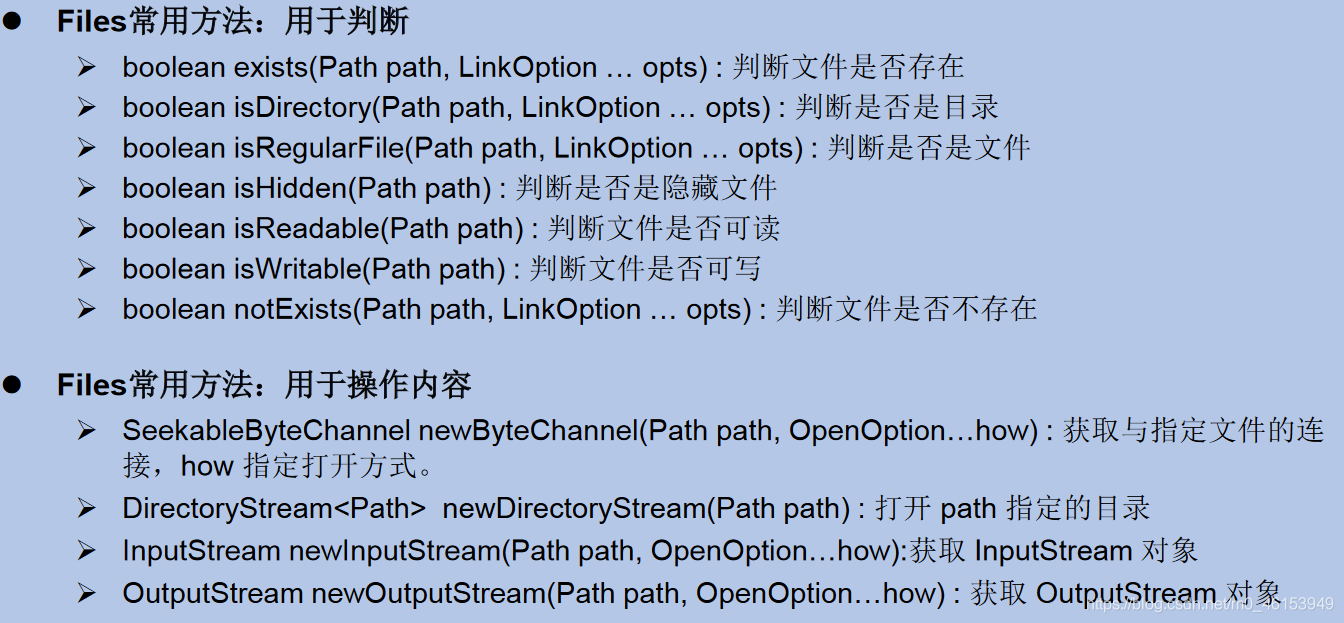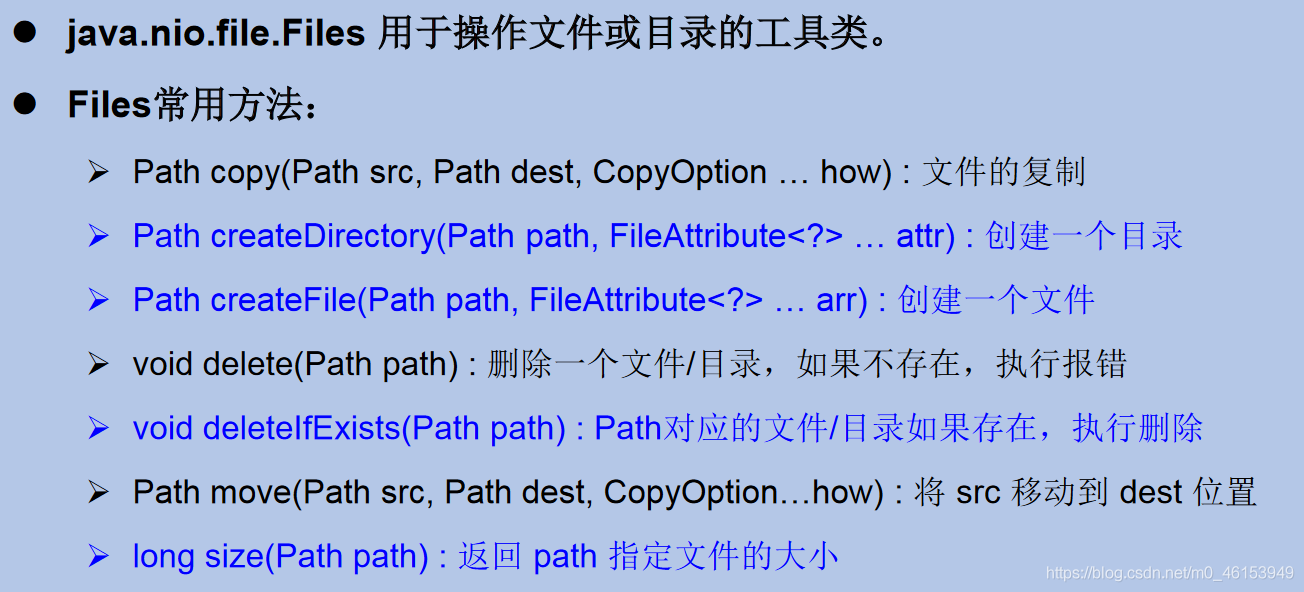15.IO流
01、File类的使用
1.1、File类的实例化
java.io.File类:文件和文件目录路径的抽象表示形式,与平台无关- File 能新建、删除、重命名文件和目录,但File 不能访问文件内容本身。如果需要访问文件内容本身,则需要使用输入/输出流。
- 想要在Java程序中表示一个真实存在的文件或目录,那么必须有一个File对象,但是Java程序中的一个File对象,可能没有一个真实存在的文件或目录。
- File对象可以作为参数传递给流的构造器
import org.junit.Test;
import java.io.File;
/**
* File类的使用
*
* 1. File类的一个对象,代表一个文件或一个文件目录(俗称:文件夹)
* 2. File类声明在java.io包下
*
*/
public class FileTest {
/**
* 1.如何创建file类的实例
* File(String filePath):以filePath为路径创建File对象,可以是绝对路径或者相对路径
* File(String parentPath,String childPath):以parentPath为父路径,childPath为子路径创建File对象。
* File(File parentFile,String childPath):根据一个父File对象和子文件路径创建File对象
* 2.
* 相对路径:相较于某个路径下,指明的路径。
* 绝对路径:包含盘符在内的文件或文件目录的路径
*
* 3.路径分隔符
* windows:\\
* unix:/
* 4.Java程序支持跨平台运行,因此路径分隔符要慎用。
*
* 5.为了解决这个隐患,File类提供了一个常量:
* public static final String separator。
* 根据操作系统,动态的提供分隔符。
*
* File file1= new File("d:\\Work\\info.txt");
* File file2= new File("d:"+ File.separator+ "Work"+ File.separator+ "info.txt");
* File file3= new File("d:/Work");
*
*/
@Test
public void test(){
//构造器1:
File file1 = new File("hello.txt");//相对于当前module
File file2 = new File("F:\\java\\Work2\\JavaSenior\\day08\\num.txt");
System.out.println(file1);
System.out.println(file2);
//构造器2:
File file3 = new File("D:\\workspace_idea1","JavaSenior");
System.out.println(file3);
//构造器3:
File file4 = new File(file3,"hi.txt");
System.out.println(file4);
}
}
1.2、File类的常用方法1
import org.junit.Test;
import java.io.File;
import java.util.Date;
/**
* File类的使用
*
* 1. File类的一个对象,代表一个文件或一个文件目录(俗称:文件夹)
* 2. File类声明在java.io包下
*/
public class FileTest {
/**
* public String getAbsolutePath():获取绝对路径
* public String getPath() :获取路径
* public String getName() :获取名称
* public String getParent():获取上层文件目录路径。若无,返回null
* public long length() :获取文件长度(即:字节数)。不能获取目录的长度。
* public long lastModified() :获取最后一次的修改时间,毫秒值
*
* 如下的两个方法适用于文件目录:
* public String[] list() :获取指定目录下的所有文件或者文件目录的名称数组
* public File[] listFiles() :获取指定目录下的所有文件或者文件目录的File数组
*/
@Test
public void test2(){
File file = new File("Hello.txt");
File file2 = new File("F:\\java\\Work2\\JavaSenior\\day08\\num.txt");
System.out.println(file.getAbsolutePath());
System.out.println(file.getPath());
System.out.println(file.getName());
System.out.println(file.getParent());
System.out.println(file.length());
System.out.println(new Date(file.lastModified()));
System.out.println();
System.out.println(file2.getAbsolutePath());
System.out.println(file2.getPath());
System.out.println(file2.getName());
System.out.println(file2.getParent());
System.out.println(file2.length());
System.out.println(file2.lastModified());
}
@Test
public void test3(){
//文件需存在!!!
File file = new File("F:\\java\\Work2\\JavaSenior");
String[] list = file.list();
for(String s : list){
System.out.println(s);
}
System.out.println();
File[] files = file.listFiles();
for(File f : files){
System.out.println(f);
}
}
/**
* File类的重命名功能
*
* public boolean renameTo(File dest):把文件重命名为指定的文件路径
* 比如:file1.renameTo(file2)为例:
* 要想保证返回true,需要file1在硬盘中是存在的,且file2不能在硬盘中存在。
*/
@Test
public void test4(){
File file1 = new File("hello.txt");
File file2 = new File("D:\\book\\num.txt");
boolean renameTo = file2.renameTo(file1);
System.out.println(renameTo);
}
}
1.3、File类的常用方法2
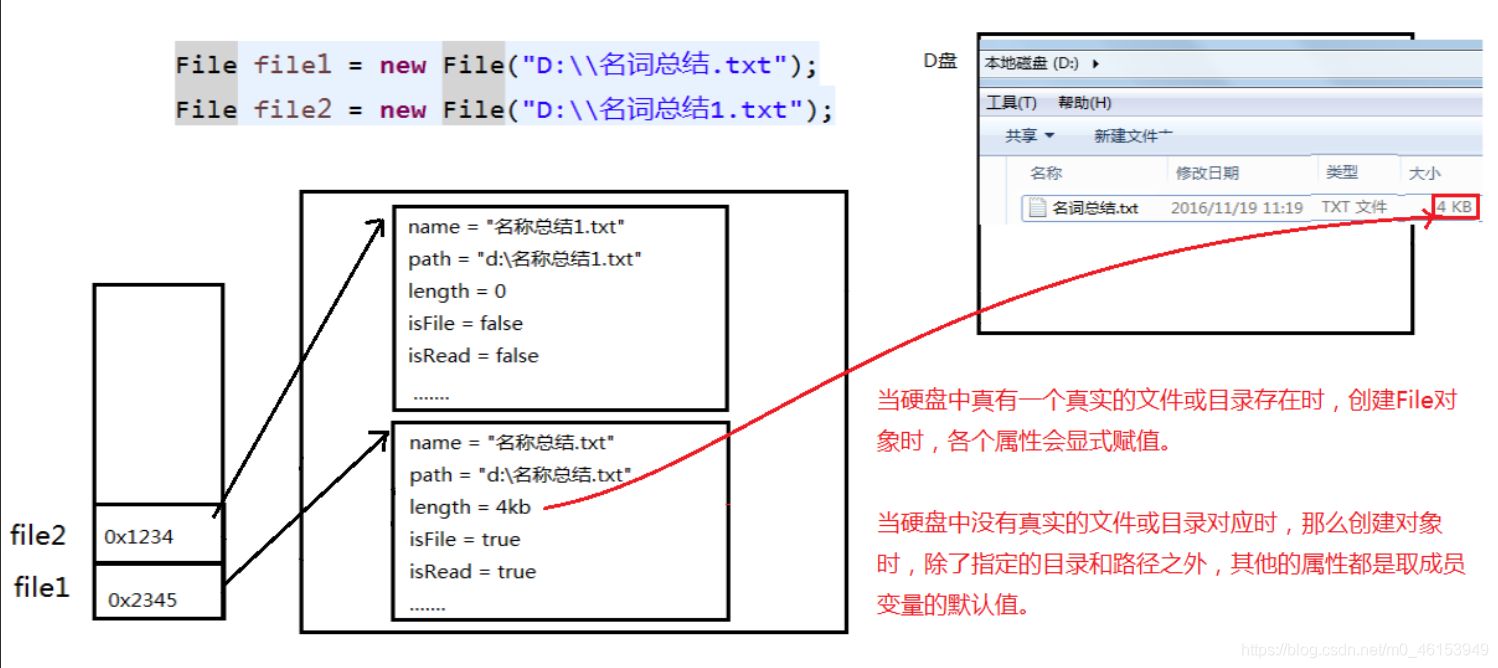
import org.junit.Test;
import java.io.File;
import java.io.IOException;
import java.util.Date;
/**
* File类的使用
*
* 1. File类的一个对象,代表一个文件或一个文件目录(俗称:文件夹)
* 2. File类声明在java.io包下
* 3. File类中涉及到关于文件或文件目录的创建、删除、重命名、修改时间、文件大小等方法,
* 并未涉及到写入或读取文件内容的操作。如果需要读取或写入文件内容,必须使用IO流来完成。
* 4. 后续File类的对象常会作为参数传递到流的构造器中,指明读取或写入的"终点".
*/
public class FileTest {
/**
* public boolean isDirectory():判断是否是文件目录
* public boolean isFile() :判断是否是文件
* public boolean exists() :判断是否存在
* public boolean canRead() :判断是否可读
* public boolean canWrite() :判断是否可写
* public boolean isHidden() :判断是否隐藏
*/
@Test
public void test5(){
File file1 = new File("hello.txt");
file1 = new File("hello1.txt");
System.out.println(file1.isDirectory());
System.out.println(file1.isFile());
System.out.println(file1.exists());
System.out.println(file1.canRead());
System.out.println(file1.canWrite());
System.out.println(file1.isHidden());
System.out.println();
File file2 = new File("D:\\book");
file2 = new File("D:\\book1");
System.out.println(file2.isDirectory());
System.out.println(file2.isFile());
System.out.println(file2.exists());
System.out.println(file2.canRead());
System.out.println(file2.canWrite());
System.out.println(file2.isHidden());
}
/**
* 创建硬盘中对应的文件或文件目录
* public boolean createNewFile() :创建文件。若文件存在,则不创建,返回false
* public boolean mkdir() :创建文件目录。如果此文件目录存在,就不创建了。如果此文件目录的上层目录不存在,也不创建。
* public boolean mkdirs() :创建文件目录。如果此文件目录存在,就不创建了。如果上层文件目录不存在,一并创建
*
* 删除磁盘中的文件或文件目录
* public boolean delete():删除文件或者文件夹
* 删除注意事项:Java中的删除不走回收站。
*/
@Test
public void test6() throws IOException {
File file1 = new File("hi.txt");
if(!file1.exists()){
//文件的创建
file1.createNewFile();
System.out.println("创建成功");
}else{//文件存在
file1.delete();
System.out.println("删除成功");
}
}
@Test
public void test7(){
//文件目录的创建
File file1 = new File("d:\\io\\io1\\io3");
boolean mkdir = file1.mkdir();
if(mkdir){
System.out.println("创建成功1");
}
File file2 = new File("d:\\io\\io1\\io4");
boolean mkdir1 = file2.mkdirs();
if(mkdir1){
System.out.println("创建成功2");
}
//要想删除成功,io4文件目录下不能有子目录或文件
File file3 = new File("D:\\io\\io1\\io4");
file3 = new File("D:\\io\\io1");
System.out.println(file3.delete());
}
}
1.4、课后练习
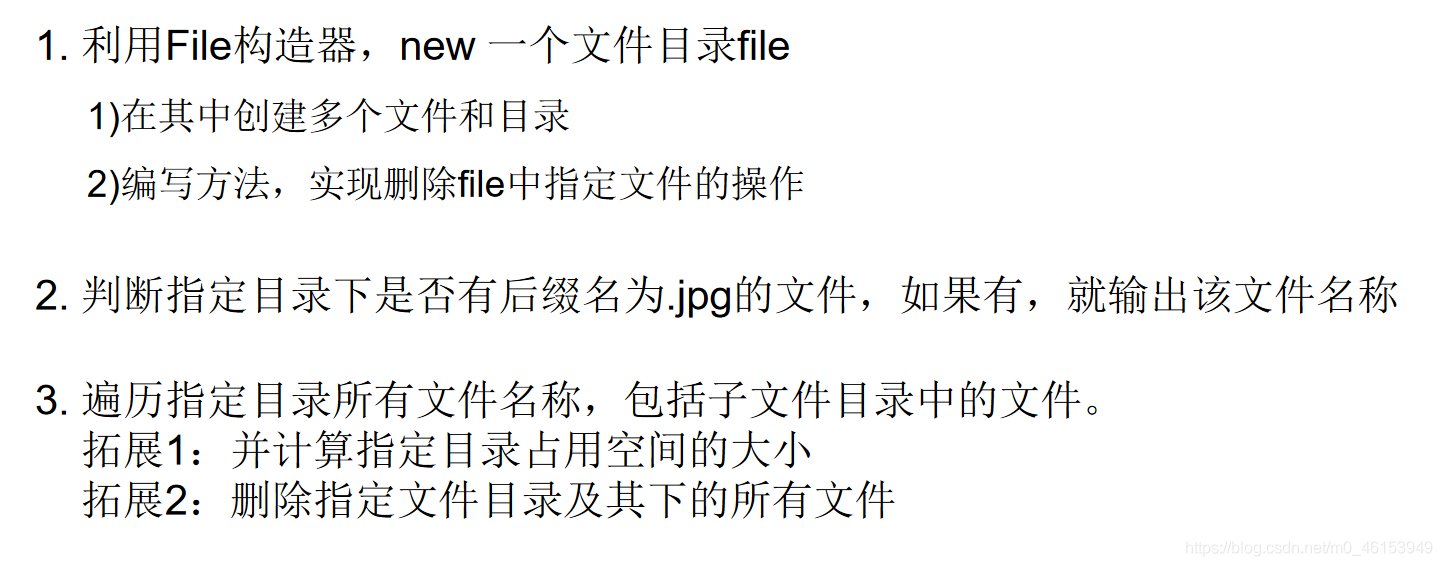
1、FileTest类
import org.junit.Test;
import java.io.File;
import java.io.IOException;
/**
* 1. 利用File构造器,new一个文件目录file
* 1)在其中创建多个文件和目录
* 2)编写方法,实现删除file中指定文件的操作
*/
public class FileTest {
@Test
public void test() throws IOException {
File file = new File("D:\\io\\io1\\hello.txt");
//创建一个与file同目录下的另外一个文件,文件名为:haha.txt
File destFile = new File(file.getParent(),"haha.txt");
boolean newFile = destFile.createNewFile();
if(newFile){
System.out.println("创建成功!");
}
}
}
2、FindJPGFileTest类
import org.junit.Test;
import java.io.File;
import java.io.FilenameFilter;
/**
* 2.判断指定目录下是否有后缀名为.jpg的文件,如果有,就输出该文件名称
*/
public class FindJPGFileTest {
@Test
public void test(){
File srcFile = new File("d:\\code");
String[] fileNames = srcFile.list();
for(String fileName : fileNames){
if(fileName.endsWith(".jpg")){
System.out.println(fileName);
}
}
}
@Test
public void test2(){
File srcFile = new File("d:\\code");
File[] listFiles = srcFile.listFiles();
for(File file : listFiles){
if(file.getName().endsWith(".jpg")){
System.out.println(file.getAbsolutePath());
}
}
}
/**
* File类提供了两个文件过滤器方法
* public String[] list(FilenameFilter filter)
* public File[] listFiles(FileFilter filter)
*/
@Test
public void test3(){
File srcFile = new File("d:\\code");
File[] subFiles = srcFile.listFiles(new FilenameFilter() {
@Override
public boolean accept(File dir, String name) {
return name.endsWith(".jpg");
}
});
for(File file : subFiles){
System.out.println(file.getAbsolutePath());
}
}
}
3、ListFilesTest类
import java.io.File;
/**
* 3. 遍历指定目录所有文件名称,包括子文件目录中的文件。
* 拓展1:并计算指定目录占用空间的大小
* 拓展2:删除指定文件目录及其下的所有文件
*/
public class ListFilesTest {
public static void main(String[] args) {
// 递归:文件目录
/** 打印出指定目录所有文件名称,包括子文件目录中的文件 */
// 1.创建目录对象
File dir = new File("E:\\teach\\01_javaSE\\_尚硅谷Java编程语言\\3_软件");
// 2.打印目录的子文件
printSubFile(dir);
}
public static void printSubFile(File dir) {
// 打印目录的子文件
File[] subfiles = dir.listFiles();
for (File f : subfiles) {
if (f.isDirectory()) {// 文件目录
printSubFile(f);
} else {// 文件
System.out.println(f.getAbsolutePath());
}
}
}
// 方式二:循环实现
// 列出file目录的下级内容,仅列出一级的话
// 使用File类的String[] list()比较简单
public void listSubFiles(File file) {
if (file.isDirectory()) {
String[] all = file.list();
for (String s : all) {
System.out.println(s);
}
} else {
System.out.println(file + "是文件!");
}
}
// 列出file目录的下级,如果它的下级还是目录,接着列出下级的下级,依次类推
// 建议使用File类的File[] listFiles()
public void listAllSubFiles(File file) {
if (file.isFile()) {
System.out.println(file);
} else {
File[] all = file.listFiles();
// 如果all[i]是文件,直接打印
// 如果all[i]是目录,接着再获取它的下一级
for (File f : all) {
listAllSubFiles(f);// 递归调用:自己调用自己就叫递归
}
}
}
// 拓展1:求指定目录所在空间的大小
// 求任意一个目录的总大小
public long getDirectorySize(File file) {
// file是文件,那么直接返回file.length()
// file是目录,把它的下一级的所有大小加起来就是它的总大小
long size = 0;
if (file.isFile()) {
size += file.length();
} else {
File[] all = file.listFiles();// 获取file的下一级
// 累加all[i]的大小
for (File f : all) {
size += getDirectorySize(f);// f的大小;
}
}
return size;
}
// 拓展2:删除指定的目录
public void deleteDirectory(File file) {
// 如果file是文件,直接delete
// 如果file是目录,先把它的下一级干掉,然后删除自己
if (file.isDirectory()) {
File[] all = file.listFiles();
// 循环删除的是file的下一级
for (File f : all) {// f代表file的每一个下级
deleteDirectory(f);
}
}
// 删除自己
file.delete();
}
}
02、IO流原理及流的分类
2.1、IO流原理
- I/O是Input/Output的缩写,I/O技术是非常实用的技术,用于处理设备之间的数据传输。如读/写文件,网络通讯等。
- Java程序中,对于数据的输入/输出操作以“流(stream)”的方式进行。
- java.io包下提供了各种“流”类和接口,用以获取不同种类的数据,并通过标准的方法输入或输出数据。
- 输入input:读取外部数据(磁盘、光盘等存储设备的数据)到程序(内存)中。
- 输出output:将程序(内存)数据输出到磁盘、光盘等存储设备中。
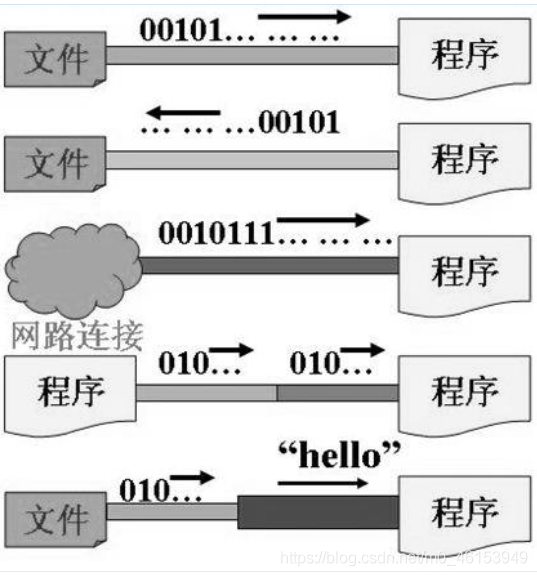
2.2、流的分类
- 按操作数据单位不同分为:字节流(8 bit),字符流(16 bit)
- 按数据流的流向不同分为:输入流,输出流
- 按流的角色的不同分为:节点流,处理流
| 抽象基类 | 字节流 | 字符流 |
|---|---|---|
| 输入流 | InputStream | Reader |
| 输出流 | OutputStream | Writer |
- Java的IO流共涉及40多个类,实际上非常规则,都是从如下4个抽象基类派生的。
- 由这四个类派生出来的子类名称都是以其父类名作为子类名后缀。
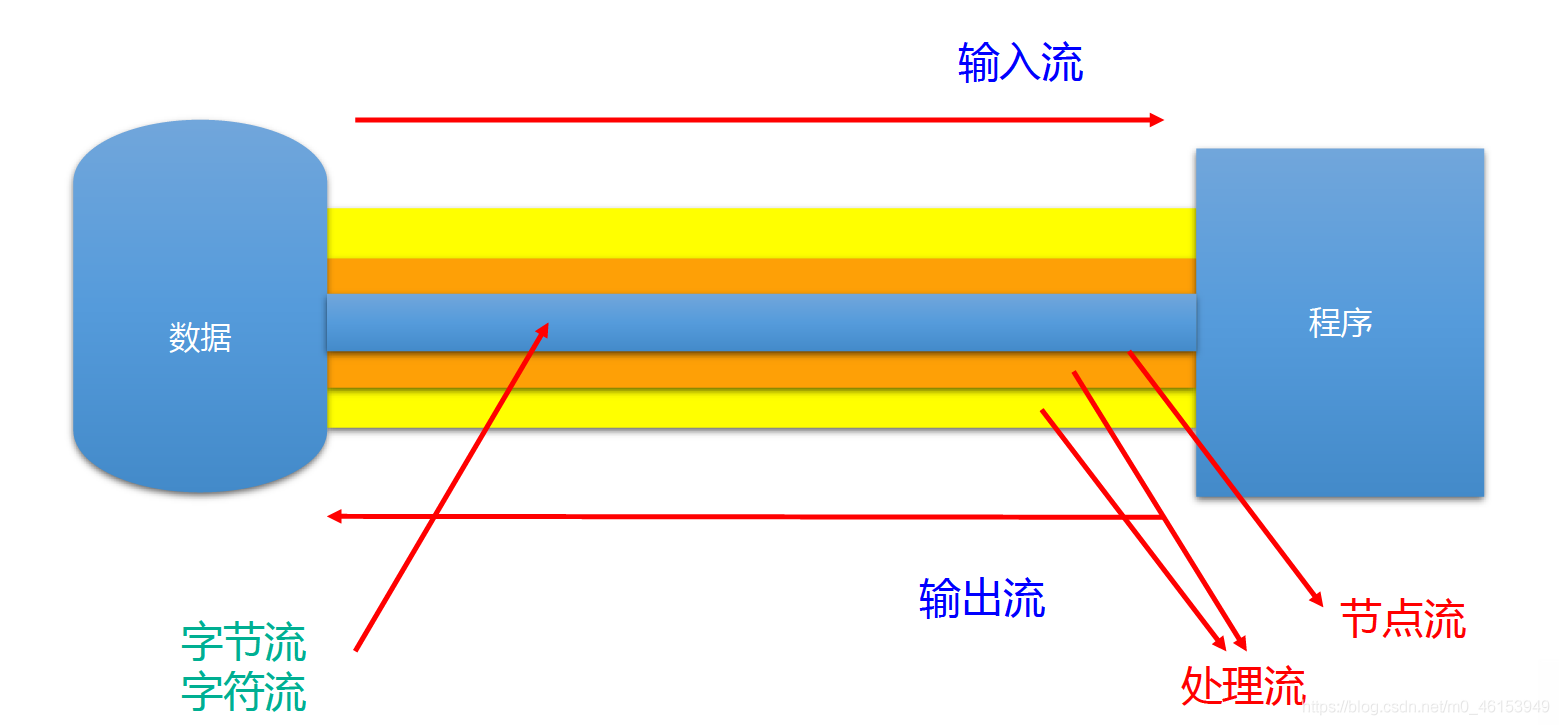
2.3、IO 流体系
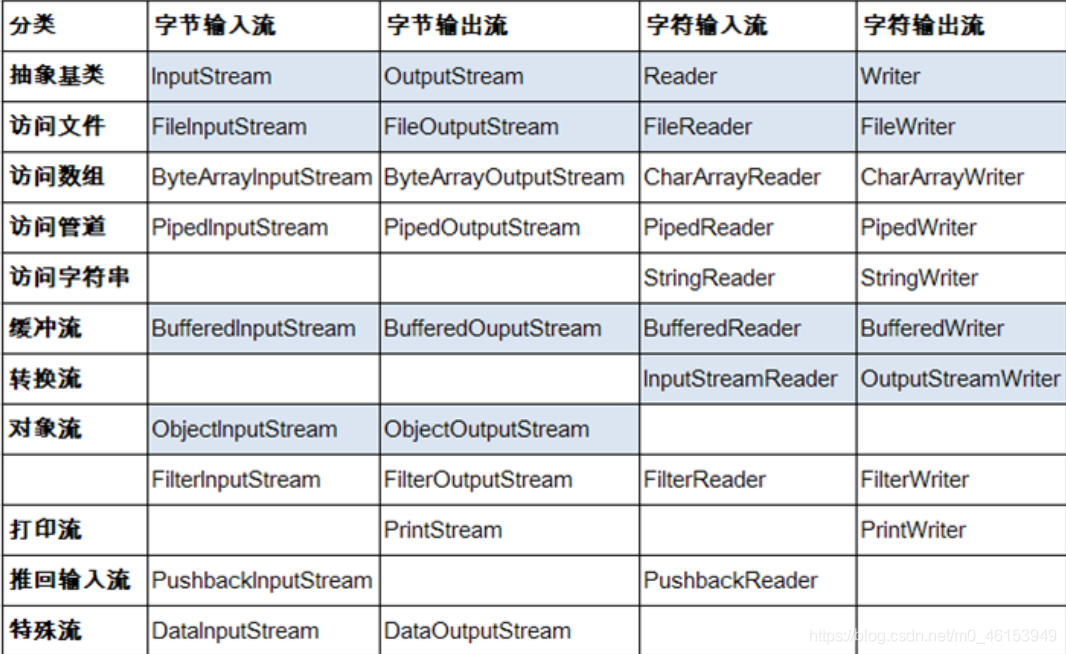
04、节点流(或文件流)
4.1、FileReader读入数据的基本操作
1、读取文件【四个步骤】
建立一个流对象,将已存在的一个文件加载进流。
FileReaderfr= new FileReader(new File(“Test.txt”));创建一个临时存放数据的数组。
char[] ch= new char[1024];调用流对象的读取方法将流中的数据读入到数组中。
fr.read(ch);关闭资源。
fr.close();
import org.junit.Test;
import java.io.File;
import java.io.FileReader;
import java.io.IOException;
/**
* 一、流的分类:
* 1.操作数据单位:字节流、字符流
* 2.数据的流向:输入流、输出流
* 3.流的角色:节点流、处理流
*
* 二、流的体系结构
* 抽象基类 节点流(或文件流) 缓冲流(处理流的一种)
* InputStream FileInputStream (read(byte[] buffer)) BufferedInputStream (read(byte[] buffer))
* OutputStream FileOutputStream (write(byte[] buffer,0,len) BufferedOutputStream (write(byte[] buffer,0,len) / flush()
* Reader FileReader (read(char[] cbuf)) BufferedReader (read(char[] cbuf) / readLine())
* Writer FileWriter (write(char[] cbuf,0,len) BufferedWriter (write(char[] cbuf,0,len) / flush()
*/
public class FileReaderWriterTest {
public static void main(String[] args) {
File file = new File("hello.txt");//相较于当前工程
System.out.println(file.getAbsolutePath());
File file1 = new File("day09\\hello.txt");
System.out.println(file1.getAbsolutePath());
}
/**
* 将day09下的hello.txt文件内容读入程序中,并输出到控制台
*
* 说明点:
* 1. read()的理解:返回读入的一个字符。如果达到文件末尾,返回-1
* 2. 异常的处理:为了保证流资源一定可以执行关闭操作。需要使用try-catch-finally处理
* 3. 读入的文件一定要存在,否则就会报FileNotFoundException。
*
*/
@Test
public void test(){
FileReader fr = null;
try {
//实例化File对象,指明要操作的文件
File file = new File("hello.txt");//相较于当前的Module
//2.提供具体的流
fr = new FileReader(file);
//3.数据的读入过程
//read():返回读入的一个字符。如果达到文件末尾,返回-1.
//方式一:
// int data = fr.read();
// while(data != -1){
// System.out.print((char) data);
// data = fr.read();
// }
//方式二:语法上针对于方式一的修改
int data;
while((data = fr.read()) != -1){
System.out.print((char) data);
}
} catch (IOException e) {
e.printStackTrace();
}finally {
//4.流的关闭操作
// try {
// if(fr != null)
// fr.close();
// } catch (IOException e) {
// e.printStackTrace();
// }
//或
if(fr != null){
try {
fr.close();
} catch (IOException e) {
e.printStackTrace();
}
}
}
}
}
4.2、FileReader中使用read(char[] cbuf)读入数据
import org.junit.Test;
import java.io.File;
import java.io.FileReader;
import java.io.IOException;
public class FileReaderWriterTest {
//对read()操作升级:使用read的重载方法
@Test
public void test2(){
FileReader fr = null;
try {
//1.File类的实例化
File file = new File("hello.txt");
//2.FileReader流的实例化
fr = new FileReader(file);
//3.读入的操作
//read(char[] cbuf):返回每次读入cbuf数组中的字符的个数。如果达到文件末尾,返回-1
char[] cbuf = new char[5];
int len;
fr.read(cbuf);
while((len = fr.read(cbuf)) != -1){
//方式一:
//错误的写法
// for(int i = 0;i < cbuf.length;i++){
// System.out.print(cbuf[i]);
// }
//正确的写法
// for(int i = 0;i < len;i++){
// System.out.print(cbuf[i]);
// }
//方式二:
//错误的写法,对应着方式一的错误的写法
// String str = new String(cbuf);
// System.out.print(str);
//正确的写法
String str = new String(cbuf,0,len);
System.out.print(str);
}
} catch (IOException e) {
e.printStackTrace();
}finally {
if(fr != null){
//4.资源的关闭
try {
fr.close();
} catch (IOException e) {
e.printStackTrace();
}
}
}
}
}
4.3、FileWriter写出数据的操作
1、写入文件
创建流对象,建立数据存放文件
FileWriterfw= new FileWriter(new File(“Test.txt”));调用流对象的写入方法,将数据写入流
fw.write(“atguigu-songhongkang”);关闭流资源,并将流中的数据清空到文件中。
fw.close();
import org.junit.Test;
import java.io.*;
public class FileReaderWriterTest {
/**
* 从内存中写出数据到硬盘的文件里。
*
* 说明:
* 1.输出操作,对应的File可以不存在的。并不会报异常
* 2.
* File对应的硬盘中的文件如果不存在,在输出的过程中,会自动创建此文件。
* File对应的硬盘中的文件如果存在:
* 如果流使用的构造器是:FileWriter(file,false) / FileWriter(file):对原有文件的覆盖
* 如果流使用的构造器是:FileWriter(file,true):不会对原有文件覆盖,而是在原有文件基础上追加内容
*/
@Test
public void test3(){
FileWriter fw = null;
try {
//1.提供File类的对象,指明写出到的文件
File file = new File("hello1.txt");
//2.提供FileWriter的对象,用于数据的写出
fw = new FileWriter(file,false);
//3.写出的操作
fw.write("I have a dream!\n");
fw.write("you need to have a dream!");
} catch (IOException e) {
e.printStackTrace();
} finally {
//4.流资源的关闭
if(fw != null){
try {
fw.close();
} catch (IOException e) {
e.printStackTrace();
}
}
}
}
}
4.4、使用FileReader和FileWriter实现文本文件的复制
import org.junit.Test;
import java.io.*;
public class FileReaderWriterTest {
@Test
public void test4() {
FileReader fr = null;
FileWriter fw = null;
try {
//1.创建File类的对象,指明读入和写出的文件
File srcFile = new File("hello1.txt");
File srcFile2 = new File("hello2..txt");
//不能使用字符流来处理图片等字节数据
// File srcFile = new File("爱情与友情.jpg");
// File srcFile2 = new File("爱情与友情1.jpg");
//2.创建输入流和输出流的对象
fr = new FileReader(srcFile);
fw = new FileWriter(srcFile2);
//3.数据的读入和写出操作
char[] cbuf = new char[5];
int len;//记录每次读入到cbuf数组中的字符的个数
while((len = fr.read(cbuf)) != -1){
//每次写出len个字符
fw.write(cbuf,0,len);
}
} catch (IOException e) {
e.printStackTrace();
} finally {
//4.关闭流资源
//方式一:
// try {
// if(fw != null)
// fw.close();
// } catch (IOException e) {
// e.printStackTrace();
// }finally{
// try {
// if(fr != null)
// fr.close();
// } catch (IOException e) {
// e.printStackTrace();
// }
// }
//方式二:
try {
if(fw != null)
fw.close();
} catch (IOException e) {
e.printStackTrace();
}
try {
if(fr != null)
fr.close();
} catch (IOException e) {
e.printStackTrace();
}
}
}
}
4.5、使用FileInputStream不能读取文本文件的测试
import org.junit.Test;
import java.io.File;
import java.io.FileInputStream;
import java.io.IOException;
/**
* 测试FileInputStream和FileOutputStream的使用
*
* 结论:
* 1. 对于文本文件(.txt,.java,.c,.cpp),使用字符流处理
* 2. 对于非文本文件(.jpg,.mp3,.mp4,.avi,.doc,.ppt,...),使用字节流处理
*/
public class FileIOPutTest {
//使用字节流FileInputStream处理文本文件,可能出现乱码。
@Test
public void testFileInputStream(){
FileInputStream fis = null;
try {
//1.造文件
File file = new File("hello.txt");
//2.造流
fis = new FileInputStream(file);
//3.读数据
byte[] buffer = new byte[5];
int len;//记录每次读取的字节的个数
while((len = fis.read(buffer)) != -1){
String str = new String(buffer,0,len);
System.out.print(str);
}
} catch (IOException e) {
e.printStackTrace();
}finally {
if(fis != null) {
//4.关闭资源
try {
fis.close();
} catch (IOException e) {
e.printStackTrace();
}
}
}
}
}
4.6、使用FileInputStream和FileOutputStream读写非文本文件
import org.junit.Test;
import java.io.File;
import java.io.FileInputStream;
import java.io.FileOutputStream;
import java.io.IOException;
public class FileIOPutTest {
/**
* 实现对图片的复制操作
*/
@Test
public void testFileInputOutputStream() {
FileInputStream fis = null;
FileOutputStream fos = null;
try {
//1.造文件
File srcFile = new File("爱情与友情.jpg");
File destFile = new File("爱情与友情2.jpg");
//2.造流
fis = new FileInputStream(srcFile);
fos = new FileOutputStream(destFile);
//3.复制的过程
byte[] buffer = new byte[5];
int len;
//4.读数据
while((len = fis.read(buffer)) != -1){
fos.write(buffer,0,len);
}
System.out.println("复制成功");
} catch (IOException e) {
e.printStackTrace();
} finally {
if(fos != null){
//5.关闭资源
try {
fos.close();
} catch (IOException e) {
e.printStackTrace();
}
}
if(fis != null){
try {
fis.close();
} catch (IOException e) {
e.printStackTrace();
}
}
}
}
}
4.7、使用FileInputStream和FileOutputStream复制文件的方法测试
import org.junit.Test;
import java.io.File;
import java.io.FileInputStream;
import java.io.FileOutputStream;
import java.io.IOException;
public class FileIOPutTest {
//指定路径下文件的复制
public void copyFile(String srcPath,String destPath){
FileInputStream fis = null;
FileOutputStream fos = null;
try {
//
File srcFile = new File(srcPath);
File destFile = new File(destPath);
//
fis = new FileInputStream(srcFile);
fos = new FileOutputStream(destFile);
//复制的过程
byte[] buffer = new byte[1024];
int len;
while((len = fis.read(buffer)) != -1){
fos.write(buffer,0,len);
}
} catch (IOException e) {
e.printStackTrace();
} finally {
if(fos != null){
//
try {
fos.close();
} catch (IOException e) {
e.printStackTrace();
}
}
if(fis != null){
try {
fis.close();
} catch (IOException e) {
e.printStackTrace();
}
}
}
}
@Test
public void testCopyFile(){
long start = System.currentTimeMillis();
// String srcPath = "C:\\Users\\29433\\Desktop\\164.jpg";
// String destPath = "C:\\Users\\29433\\Desktop\\164.jpg";
String srcPath = "hello.txt";
String destPath = "hello3.txt";
copyFile(srcPath,destPath);
long end = System.currentTimeMillis();
System.out.println("复制操作花费的时间为:" + (end - start));//1
}
}
05、缓冲流
为了提高数据读写的速度,Java API提供了带缓冲功能的流类,在使用这些流类时,会创建一个内部缓冲区数组,缺省使用8192个字节(8Kb)的缓冲区。

缓冲流要“套接”在相应的节点流之上,根据数据操作单位可以把缓冲流分为:
- BufferedInputStream和BufferedOutputStream
- BufferedReader和BufferedWriter
当读取数据时,数据按块读入缓冲区,其后的读操作则直接访问缓冲区
当使用BufferedInputStream读取字节文件时,BufferedInputStream会一次性从文件中读取8192个(8Kb),存在缓冲区中,直到缓冲区装满了,才重新从文件中读取下一个8192个字节数组。
向流中写入字节时,不会直接写到文件,先写到缓冲区中直到缓冲区写满,BufferedOutputStream才会把缓冲区中的数据一次性写到文件里。使用方法flush()可以强制将缓冲区的内容全部写入输出流
关闭流的顺序和打开流的顺序相反。只要关闭最外层流即可,关闭最外层流也会相应关闭内层节点流
flush()方法的使用:手动将buffer中内容写入文件
如果是带缓冲区的流对象的close()方法,不但会关闭流,还会在关闭流之前刷新缓冲区,关闭后不能再写出。
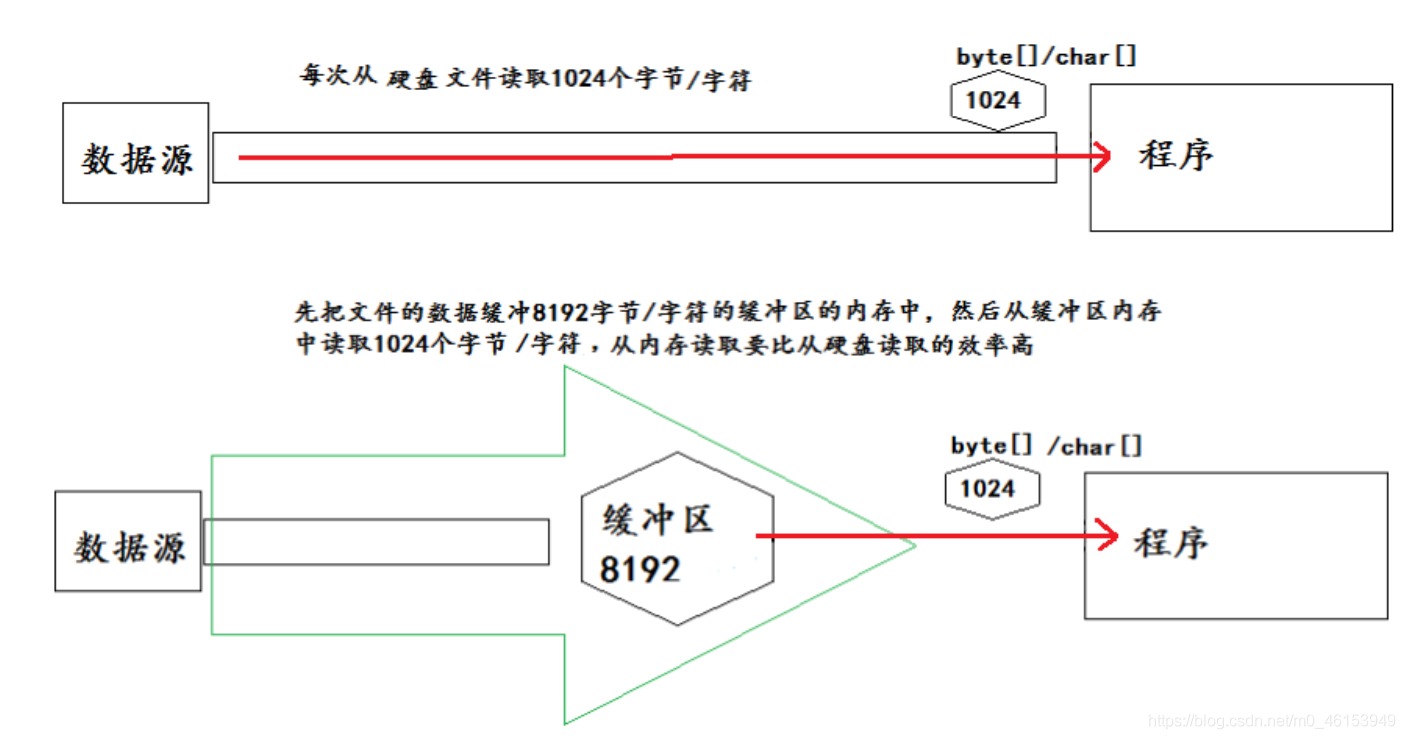
5.1、缓冲流(字节型)实现非文本文件的复制
import org.junit.Test;
import java.io.*;
/**
* 处理流之一:缓冲流的使用
*
* 1.缓冲流:
* BufferedInputStream
* BufferedOutputStream
* BufferedReader
* BufferedWriter
*/
public class BufferedTest {
/**
* 实现非文本文件的复制
*/
@Test
public void BufferedStreamTest(){
BufferedInputStream bis = null;
BufferedOutputStream bos = null;
try {
//1.造文件
File srcFile = new File("爱情与友情.jpg");
File destFile = new File("爱情与友情3.jpg");
//2.造流
//2.1 造节点流
FileInputStream fis = new FileInputStream((srcFile));
FileOutputStream fos = new FileOutputStream(destFile);
//2.2 造缓冲流
bis = new BufferedInputStream(fis);
bos = new BufferedOutputStream(fos);
//3.复制的细节:读取、写入
byte[] buffer = new byte[10];
int len;
while((len = bis.read(buffer)) != -1){
bos.write(buffer,0,len);
// bos.flush();//刷新缓冲区
}
} catch (IOException e) {
e.printStackTrace();
} finally {
//4.资源关闭
//要求:先关闭外层的流,再关闭内层的流
if(bos != null){
try {
bos.close();
} catch (IOException e) {
e.printStackTrace();
}
}
if(bis != null){
try {
bis.close();
} catch (IOException e) {
e.printStackTrace();
}
}
//说明:关闭外层流的同时,内层流也会自动的进行关闭。关于内层流的关闭,我们可以省略.
// fos.close();
// fis.close();
}
}
}
5.2、缓冲流与节点流读写速度对比
import org.junit.Test;
import java.io.*;
/**
* 处理流之一:缓冲流的使用
*
* 1.缓冲流:
* BufferedInputStream
* BufferedOutputStream
* BufferedReader
* BufferedWriter
*
* 2.作用:提供流的读取、写入的速度
* 提高读写速度的原因:内部提供了一个缓冲区
*
* 3. 处理流,就是“套接”在已有的流的基础上。
*
*/
public class BufferedTest {
//实现文件复制的方法
public void copyFileWithBuffered(String srcPath,String destPath){
BufferedInputStream bis = null;
BufferedOutputStream bos = null;
try {
//1.造文件
File srcFile = new File(srcPath);
File destFile = new File(destPath);
//2.造流
//2.1 造节点流
FileInputStream fis = new FileInputStream((srcFile));
FileOutputStream fos = new FileOutputStream(destFile);
//2.2 造缓冲流
bis = new BufferedInputStream(fis);
bos = new BufferedOutputStream(fos);
//3.复制的细节:读取、写入
byte[] buffer = new byte[1024];
int len;
while((len = bis.read(buffer)) != -1){
bos.write(buffer,0,len);
}
} catch (IOException e) {
e.printStackTrace();
} finally {
//4.资源关闭
//要求:先关闭外层的流,再关闭内层的流
if(bos != null){
try {
bos.close();
} catch (IOException e) {
e.printStackTrace();
}
}
if(bis != null){
try {
bis.close();
} catch (IOException e) {
e.printStackTrace();
}
}
//说明:关闭外层流的同时,内层流也会自动的进行关闭。关于内层流的关闭,我们可以省略.
// fos.close();
// fis.close();
}
}
@Test
public void testCopyFileWithBuffered(){
long start = System.currentTimeMillis();
String srcPath = "C:\\Users\\29433\\Desktop\\book.flv";
String destPath = "C:\\Users\\29433\\Desktop\\book1.flv";
copyFileWithBuffered(srcPath,destPath);
long end = System.currentTimeMillis();
System.out.println("复制操作花费的时间为:" + (end - start));//1
}
}
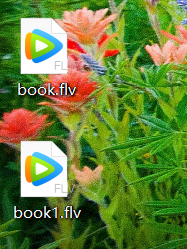
5.3、缓冲流(字符型)实现文本文件的复制
import org.junit.Test;
import java.io.*;
public class BufferedTest {
/**
* 使用BufferedReader和BufferedWriter实现文本文件的复制
*/
@Test
public void test4(){
BufferedReader br = null;
BufferedWriter bw = null;
try {
//创建文件和相应的流
br = new BufferedReader(new FileReader(new File("dbcp.txt")));
bw = new BufferedWriter(new FileWriter(new File("dbcp1.txt")));
//读写操作
//方式一:使用char[]数组
// char[] cbuf = new char[1024];
// int len;
// while((len = br.read(cbuf)) != -1){
// bw.write(cbuf,0,len);
// // bw.flush();
// }
//方式二:使用String
String data;
while((data = br.readLine()) != null){
//方法一:
// bw.write(data + "\n");//data中不包含换行符
//方法二:
bw.write(data);//data中不包含换行符
bw.newLine();//提供换行的操作
}
} catch (IOException e) {
e.printStackTrace();
} finally {
//关闭资源
if(bw != null){
try {
bw.close();
} catch (IOException e) {
e.printStackTrace();
}
}
if(br != null){
try {
br.close();
} catch (IOException e) {
e.printStackTrace();
}
}
}
}
}

5.4、缓冲流课后练习
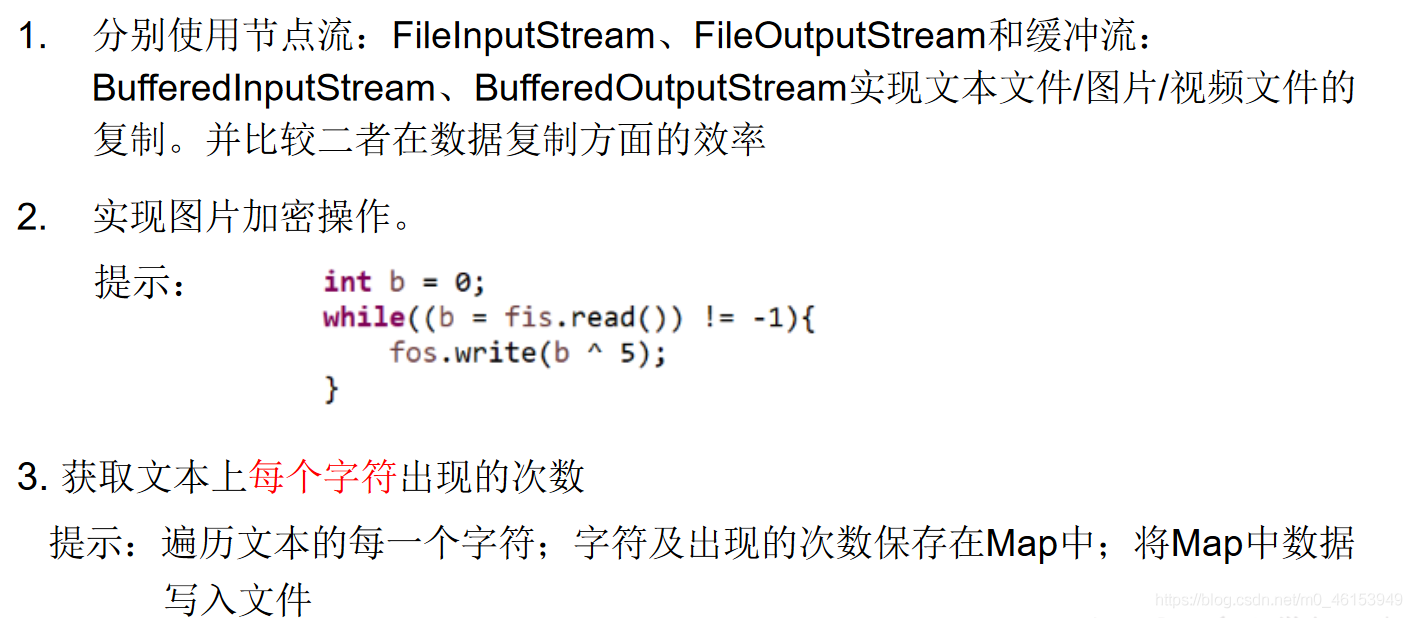
1、练习2
package git;
import org.junit.Test;
import java.io.FileInputStream;
import java.io.FileOutputStream;
import java.io.IOException;
public class PicTest {
//图片的加密
@Test
public void test() {
FileInputStream fis = null;
FileOutputStream fos = null;
try {
fis = new FileInputStream("爱情与友情.jpg");
fos = new FileOutputStream("爱情与友情secret.jpg");
byte[] buffer = new byte[20];
int len;
while ((len = fis.read(buffer)) != -1) {
//字节数组进行修改
//错误的
// for(byte b : buffer){
// b = (byte) (b ^ 5);
// }
//正确的
for (int i = 0; i < len; i++) {
buffer[i] = (byte) (buffer[i] ^ 5);
}
fos.write(buffer, 0, len);
}
} catch (IOException e) {
e.printStackTrace();
} finally {
if (fos != null) {
try {
fos.close();
} catch (IOException e) {
e.printStackTrace();
}
}
if (fis != null) {
try {
fis.close();
} catch (IOException e) {
e.printStackTrace();
}
}
}
}
//图片的解密
@Test
public void test2() {
FileInputStream fis = null;
FileOutputStream fos = null;
try {
fis = new FileInputStream("爱情与友情secret.jpg");
fos = new FileOutputStream("爱情与友情4.jpg");
byte[] buffer = new byte[20];
int len;
while ((len = fis.read(buffer)) != -1) {
//字节数组进行修改
//错误的
// for(byte b : buffer){
// b = (byte) (b ^ 5);
// }
//正确的
for (int i = 0; i < len; i++) {
buffer[i] = (byte) (buffer[i] ^ 5);
}
fos.write(buffer, 0, len);
}
} catch (IOException e) {
e.printStackTrace();
} finally {
if (fos != null) {
try {
fos.close();
} catch (IOException e) {
e.printStackTrace();
}
}
if (fis != null) {
try {
fis.close();
} catch (IOException e) {
e.printStackTrace();
}
}
}
}
}
2、练习3
import org.junit.Test;
import java.io.BufferedWriter;
import java.io.FileReader;
import java.io.FileWriter;
import java.io.IOException;
import java.util.HashMap;
import java.util.Map;
import java.util.Set;
/**
* 练习3:获取文本上字符出现的次数,把数据写入文件
*
* 思路:
* 1.遍历文本每一个字符
* 2.字符出现的次数存在Map中
*
* Map<Character,Integer> map = new HashMap<Character,Integer>();
* map.put('a',18);
* map.put('你',2);
*
* 3.把map中的数据写入文件
*/
public class WordCount {
/**
* 说明:如果使用单元测试,文件相对路径为当前module
* 如果使用main()测试,文件相对路径为当前工程
*/
@Test
public void testWordCount() {
FileReader fr = null;
BufferedWriter bw = null;
try {
//1.创建Map集合
Map<Character, Integer> map = new HashMap<Character, Integer>();
//2.遍历每一个字符,每一个字符出现的次数放到map中
fr = new FileReader("dbcp.txt");
int c = 0;
while ((c = fr.read()) != -1) {
//int 还原 char
char ch = (char) c;
// 判断char是否在map中第一次出现
if (map.get(ch) == null) {
map.put(ch, 1);
} else {
map.put(ch, map.get(ch) + 1);
}
}
//3.把map中数据存在文件count.txt
//3.1 创建Writer
bw = new BufferedWriter(new FileWriter("wordcount.txt"));
//3.2 遍历map,再写入数据
Set<Map.Entry<Character, Integer>> entrySet = map.entrySet();
for (Map.Entry<Character, Integer> entry : entrySet) {
switch (entry.getKey()) {
case ' ':
bw.write("空格=" + entry.getValue());
break;
case '\t'://\t表示tab 键字符
bw.write("tab键=" + entry.getValue());
break;
case '\r'://
bw.write("回车=" + entry.getValue());
break;
case '\n'://
bw.write("换行=" + entry.getValue());
break;
default:
bw.write(entry.getKey() + "=" + entry.getValue());
break;
}
bw.newLine();
}
} catch (IOException e) {
e.printStackTrace();
} finally {
//4.关流
if (fr != null) {
try {
fr.close();
} catch (IOException e) {
e.printStackTrace();
}
}
if (bw != null) {
try {
bw.close();
} catch (IOException e) {
e.printStackTrace();
}
}
}
}
}
06、转换流
6.1、转换流概述与InputStreamReader的使用
- 转换流提供了在字节流和字符流之间的转换
- Java API提供了两个转换流:
InputStreamReader:将InputStream转换为Reader- 实现将字节的输入流按指定字符集转换为字符的输入流。
- 需要和
InputStream“套接”。 - 构造器
public InputStreamReader(InputStreamin)public InputSreamReader(InputStreamin,StringcharsetName)如:Reader isr= new InputStreamReader(System.in,”gbk”);
OutputStreamWriter:将Writer转换为OutputStream- 实现将字符的输出流按指定字符集转换为字节的输出流。
- 需要和
OutputStream“套接”。 - 构造器
public OutputStreamWriter(OutputStreamout)public OutputSreamWriter(OutputStreamout,StringcharsetName)
- 字节流中的数据都是字符时,转成字符流操作更高效。
- 很多时候我们使用转换流来处理文件乱码问题。实现编码和解码的功能。
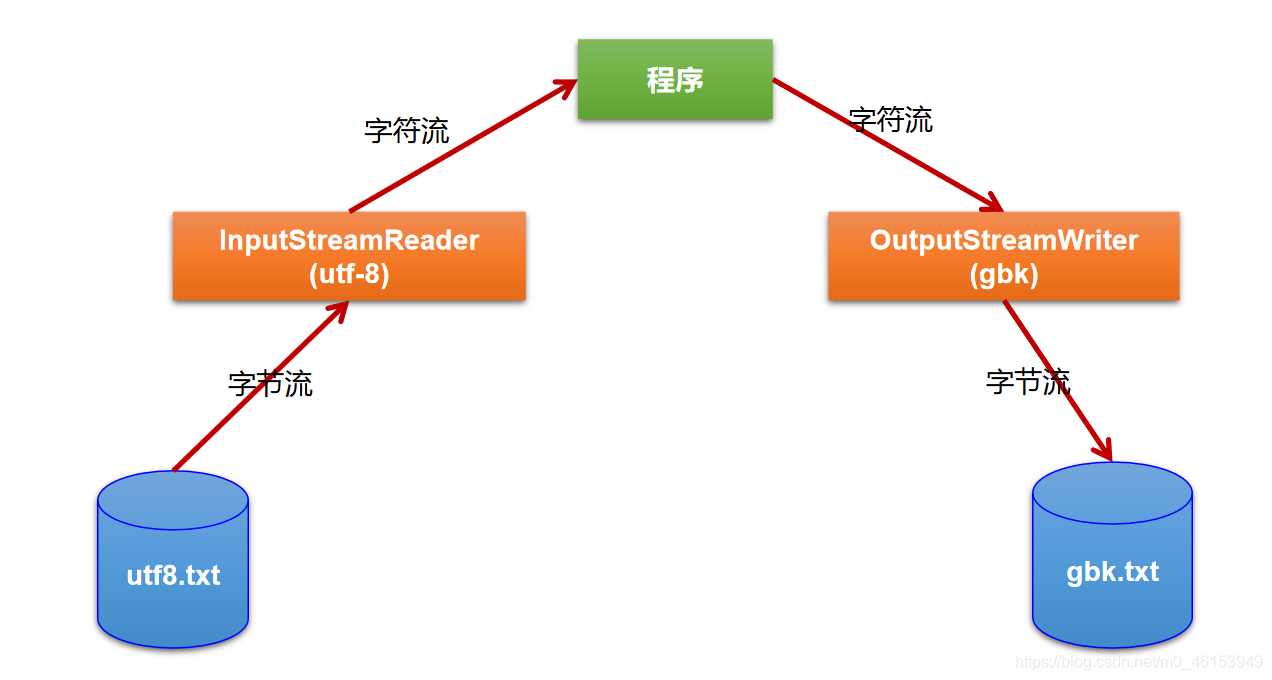
import org.junit.Test;
import java.io.FileInputStream;
import java.io.IOException;
import java.io.InputStreamReader;
/**
* 处理流之二:转换流的使用
* 1.转换流:属于字符流
* InputStreamReader:将一个字节的输入流转换为字符的输入流
* OutputStreamWriter:将一个字符的输出流转换为字节的输出流
*
* 2.作用:提供字节流与字符流之间的转换
*
* 3.解码:字节、字节数组 --->字符数组、字符串
* 编码:字符数组、字符串 ---> 字节、字节数组
*
* 4.字符集
*/
public class InputStreamReaderTest {
/**
* 此时处理异常的话,仍然应该使用try-catch-finally
* InputStreamReader的使用,实现字节的输入流到字符的输入流的转换
*/
@Test
public void test() throws IOException {
FileInputStream fis = new FileInputStream("dbcp.txt");
// InputStreamReader isr = new InputStreamReader(fis);//使用系统默认的字符集
//参数2指明了字符集,具体使用哪个字符集,取决于文件dbcp.txt保存时使用的字符集
InputStreamReader isr = new InputStreamReader(fis,"UTF-8");//使用系统默认的字符集
char[] cbuf = new char[20];
int len;
while((len = isr.read(cbuf)) != -1){
String str = new String(cbuf,0,len);
System.out.print(str);
}
isr.close();
}
}
6.2、转换流实现文件的读入和写出
import org.junit.Test;
import java.io.*;
/**
* 处理流之二:转换流的使用
* 1.转换流:属于字符流
* InputStreamReader:将一个字节的输入流转换为字符的输入流
* OutputStreamWriter:将一个字符的输出流转换为字节的输出流
*
* 2.作用:提供字节流与字符流之间的转换
*
* 3.解码:字节、字节数组 --->字符数组、字符串
* 编码:字符数组、字符串 ---> 字节、字节数组
*
* 4.字符集
*/
public class InputStreamReaderTest {
/**
* 此时处理异常的话,仍然应该使用try-catch-finally
* 综合使用InputStreamReader和OutputStreamWriter
*/
@Test
public void test2() throws IOException {
//1.造文件、造流
File file1 = new File("dbcp.txt");
File file2 = new File("dbcp_gbk.txt");
FileInputStream fis = new FileInputStream(file1);
FileOutputStream fos = new FileOutputStream(file2);
InputStreamReader isr = new InputStreamReader(fis,"utf-8");
OutputStreamWriter osw = new OutputStreamWriter(fos,"gbk");
//2.读写过程
char[] cbuf = new char[20];
int len;
while((len = isr.read(cbuf)) != -1){
osw.write(cbuf,0,len);
}
//3.关闭资源
isr.close();
osw.close();
}
}
6.3、多种字符编码集的说明
1、编码表的由来
计算机只能识别二进制数据,早期由来是电信号。为了方便应用计算机,让它可以识别各个国家的文字。就将各个国家的文字用数字来表示,并一一对应,形成一张表。这就是编码表。
2、常见的编码表
/**
* 4.字符集
* ASCII:美国标准信息交换码。
* 用一个字节的7位可以表示。
* ISO8859-1:拉丁码表。欧洲码表
* 用一个字节的8位表示。
* GB2312:中国的中文编码表。最多两个字节编码所有字符
* GBK:中国的中文编码表升级,融合了更多的中文文字符号。最多两个字节编码
* Unicode:国际标准码,融合了目前人类使用的所有字符。为每个字符分配唯一的字符码。所有的文字都用两个字节来表示。
* UTF-8:变长的编码方式,可用1-4个字节来表示一个字符。
*/
说明:
- Unicode不完美,这里就有三个问题,
一个是,我们已经知道,英文字母只用一个字节表示就够了,
第二个问题是如何才能区别Unicode和ASCII?计算机怎么知道两个字节表示一个符号,而不是分别表示两个符号呢?
第三个,如果和GBK等双字节编码方式一样,用最高位是1或0表示两个字节和一个字节,就少了很多值无法用于表示字符,不够表示所有字符。Unicode在很长一段时间内无法推广,直到互联网的出现。 - 面向传输的众多UTF(UCS Transfer Format)标准出现了,顾名思义,**UTF-8就是每次8个位传输数据,而UTF-16就是每次16个位。**这是为传输而设计的编码,并使编码无国界,这样就可以显示全世界上所有文化的字符了。
- Unicode只是定义了一个庞大的、全球通用的字符集,并为每个字符规定了唯一确定的编号,具体存储成什么样的字节流,取决于字符编码方案。推荐的Unicode编码是UTF-8和UTF-16。
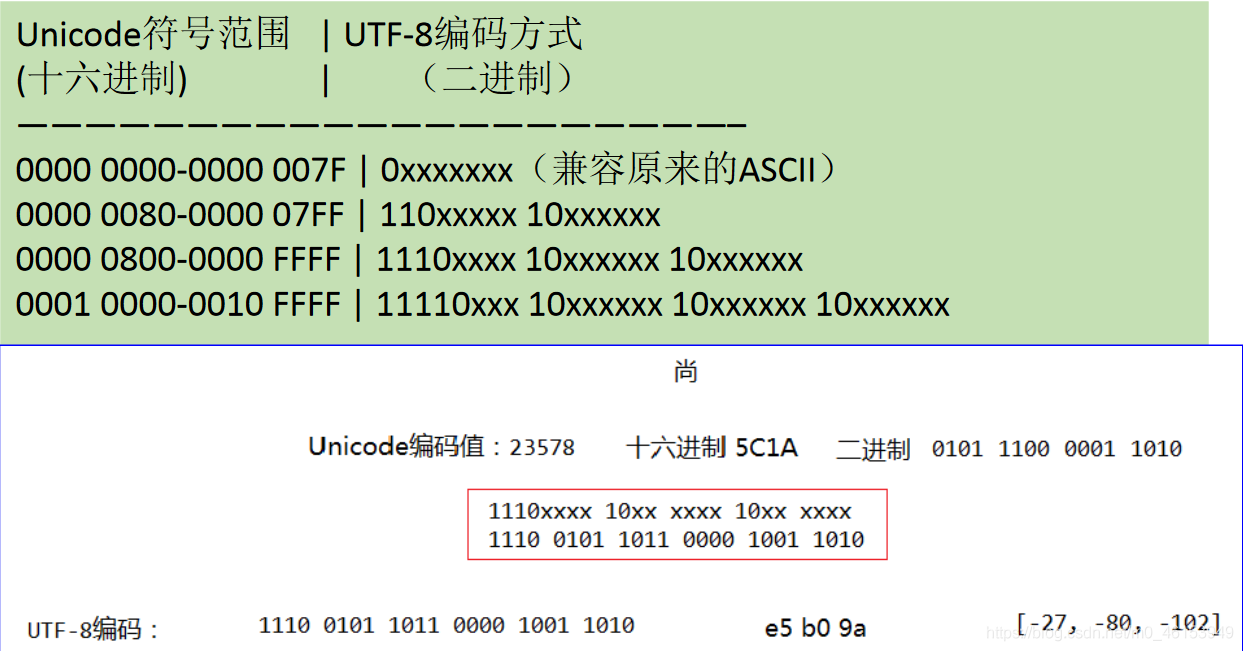
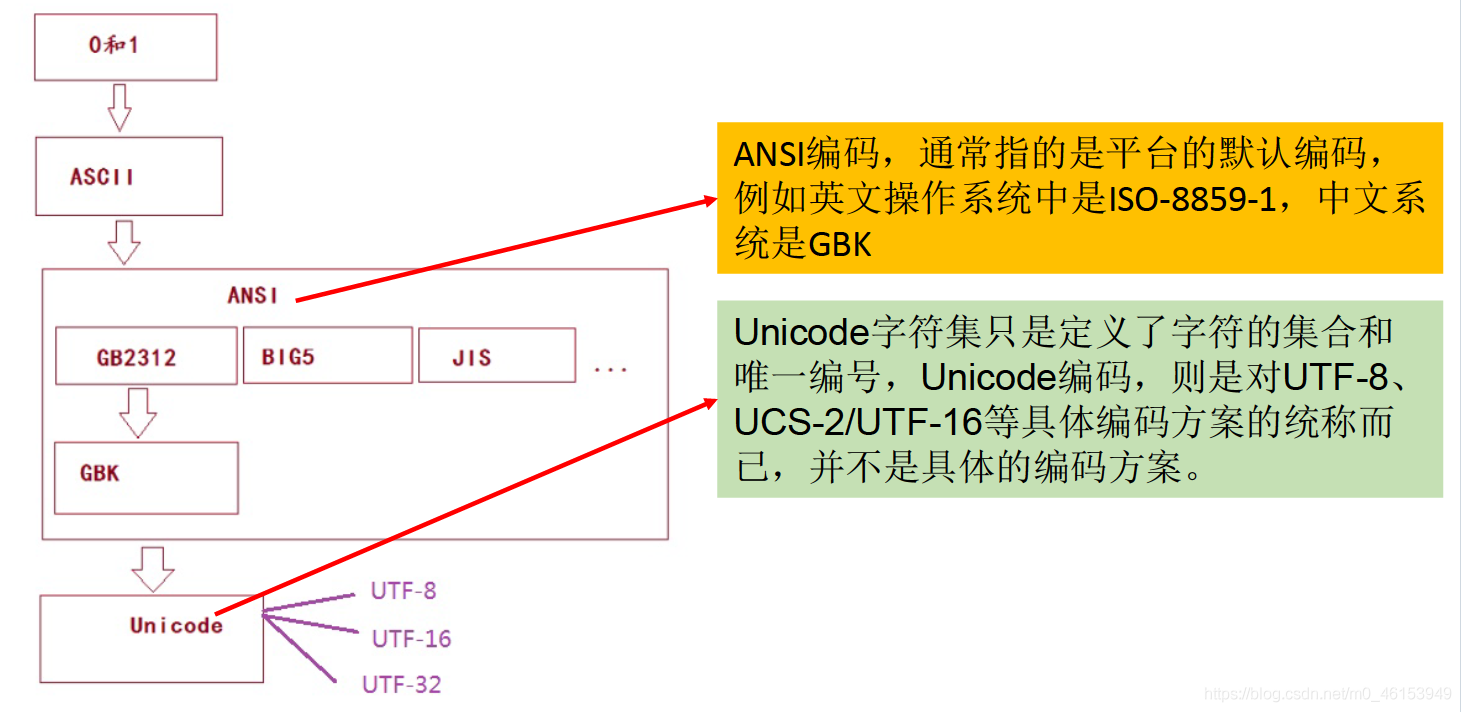
07、标准输入、输出流
- System.in和System.out分别代表了系统标准的输入和输出设备
- 默认输入设备是:键盘,输出设备是:显示器
- System.in的类型是InputStream
- System.out的类型是PrintStream,其是OutputStream的子类FilterOutputStream的子类
- 重定向:通过System类的setIn,setOut方法对默认设备进行改变。
- public static void setIn(InputStreamin)
- public static void setOut(PrintStreamout)
import org.junit.Test;
import java.io.BufferedReader;
import java.io.IOException;
import java.io.InputStreamReader;
/**
* 其他流的使用
* 1.标准的输入、输出流
* 2.打印流
* 3.数据流
*/
public class OtherStreamTest {
/**
* 1.标准的输入、输出流
* 1.1
* System.in:标准的输入流,默认从键盘输入
* System.out:标准的输出流,默认从控制台输出
* 1.2
* System类的setIn(InputStream is) / setOut(PrintStream ps)方式重新指定输入和输出的流。
*
* 1.3练习:
* 从键盘输入字符串,要求将读取到的整行字符串转成大写输出。然后继续进行输入操作,
* 直至当输入“e”或者“exit”时,退出程序。
*
* 方法一:使用Scanner实现,调用next()返回一个字符串
* 方法二:使用System.in实现。System.in ---> 转换流 ---> BufferedReader的readLine()
*/
@Test
public void test(){
BufferedReader br = null;
try {
InputStreamReader isr = new InputStreamReader(System.in);
br = new BufferedReader(isr);
while (true) {
System.out.println("请输入字符串:");
String data = br.readLine();
if ("e".equalsIgnoreCase(data) || "exit".equalsIgnoreCase(data)) {
System.out.println("程序结束");
break;
}
String upperCase = data.toUpperCase();
System.out.println(upperCase);
}
} catch (IOException e) {
e.printStackTrace();
} finally {
if (br != null) {
try {
br.close();
} catch (IOException e) {
e.printStackTrace();
}
}
}
}
}
08、打印流
- 实现将基本数据类型的数据格式转化为字符串输出
- 打印流:PrintStream和PrintWriter
- 提供了一系列重载的print()和println()方法,用于多种数据类型的输出
- PrintStream和PrintWriter的输出不会抛出IOException异常
- PrintStream和PrintWriter有自动flush功能
- PrintStream 打印的所有字符都使用平台的默认字符编码转换为字节。在需要写入字符而不是写入字节的情况下,应该使用PrintWriter 类。
- System.out返回的是PrintStream的实例
import org.junit.Test;
import java.io.*;
public class OtherStreamTest {
/**
* 2. 打印流:PrintStream 和PrintWriter
* 2.1 提供了一系列重载的print() 和 println()
* 2.2 练习:
*/
@Test
public void test2(){
PrintStream ps = null;
try {
FileOutputStream fos = new FileOutputStream(new File("D:\\IO\\text.txt"));
// 创建打印输出流,设置为自动刷新模式(写入换行符或字节 '\n' 时都会刷新输出缓冲区)
ps = new PrintStream(fos, true);
if (ps != null) {// 把标准输出流(控制台输出)改成文件
System.setOut(ps);
}
for (int i = 0; i <= 255; i++) { // 输出ASCII字符
System.out.print((char) i);
if (i % 50 == 0) { // 每50个数据一行
System.out.println(); // 换行
}
}
} catch (FileNotFoundException e) {
e.printStackTrace();
} finally {
if (ps != null) {
ps.close();
}
}
}
}
09、数据流
为了方便地操作Java语言的基本数据类型和String的数据,可以使用数据流。
数据流有两个类:(用于读取和写出基本数据类型、String类的数据)
- DataInputStream和DataOutputStream
- 分别“套接”在InputStream和OutputStream子类的流上
DataInputStream中的方法
boolean readBoolean() byte readByte() char readChar() float readFloat() double readDouble() short readShort() long readLong() int readInt() String readUTF() void readFully(byte[s] b)DataOutputStream中的方法
- 将上述的方法的read改为相应的write即可。
import org.junit.Test;
import java.io.*;
public class OtherStreamTest {
/**
* 3.数据流
* 3.1 DataInputStream 和 DataOutputStream
* 3.2 作用:用于读取或写出基本数据类型的变量或字符串
*
* 练习:将内存中的字符串、基本数据类型的变量写出到文件中。
*
* 注意:处理异常的话,仍然应该使用try-catch-finally.
*/
@Test
public void test3() throws IOException {
//1.
DataOutputStream dos = new DataOutputStream(new FileOutputStream("data.txt"));
//2.
dos.writeUTF("刘刚");
dos.flush();//刷新操作,将内存中的数据写入文件
dos.writeInt(23);
dos.flush();
dos.writeBoolean(true);
dos.flush();
//3.
dos.close();
}
/**
* 将文件中存储的基本数据类型变量和字符串读取到内存中,保存在变量中。
*
* 注意点:读取不同类型的数据的顺序要与当初写入文件时,保存的数据的顺序一致!
*/
@Test
public void test4() throws IOException {
//1.
DataInputStream dis = new DataInputStream(new FileInputStream("data.txt"));
//2.
String name = dis.readUTF();
int age = dis.readInt();
boolean isMale = dis.readBoolean();
System.out.println("name = " + name);
System.out.println("age = " + age);
System.out.println("isMale = " + isMale);
//3.
dis.close();
}
}
10、对象流
10.1、对象序列化机制的理解
ObjectInputStream和OjbectOutputSteam- 用于存储和读取基本数据类型数据或对象的处理流。它的强大之处就是可以把Java中的对象写入到数据源中,也能把对象从数据源中还原回来。
- 序列化:用
ObjectOutputStream类保存基本类型数据或对象的机制 - 反序列化:用
ObjectInputStream类读取基本类型数据或对象的机制 ObjectOutputStream和ObjectInputStream不能序列化static和transient修饰的成员变量- 对象序列化机制允许把内存中的Java对象转换成平台无关的二进制流,从而允许把这种二进制流持久地保存在磁盘上,或通过网络将这种二进制流传输到另一个网络节点。//当其它程序获取了这种二进制流,就可以恢复成原来的Java对象
- 序列化的好处在于可将任何实现了Serializable接口的对象转化为字节数据,使其在保存和传输时可被还原
- 序列化是RMI(Remote Method Invoke –远程方法调用)过程的参数和返回值都必须实现的机制,而RMI 是JavaEE的基础。因此序列化机制是JavaEE平台的基础
- 如果需要让某个对象支持序列化机制,则必须让对象所属的类及其属性是可序列化的,为了让某个类是可序列化的,该类必须实现如下两个接口之一。否则,会抛出
NotSerializableException异常SerializableExternalizable
10.2、对象流序列化与反序列化字符串操作
import org.junit.Test;
import java.io.*;
/**
* 对象流的使用
* 1.ObjectInputStream 和 ObjectOutputStream
* 2.作用:用于存储和读取基本数据类型数据或对象的处理流。它的强大之处就是可以把Java中的对象写入到数据源中,也能把对象从数据源中还原回来。
*/
public class ObjectTest {
/**
* 序列化过程:将内存中的java对象保存到磁盘中或通过网络传输出去
* 使用ObjectOutputStream实现
*/
@Test
public void test(){
ObjectOutputStream oos = null;
try {
//创造流
oos = new ObjectOutputStream(new FileOutputStream("object.dat"));
//制造对象
oos.writeObject(new String("秦始皇陵欢迎你"));
//刷新操作
oos.flush();
} catch (IOException e) {
e.printStackTrace();
} finally {
if(oos != null){
//3.关闭流
try {
oos.close();
} catch (IOException e) {
e.printStackTrace();
}
}
}
}
/**
* 反序列化:将磁盘文件中的对象还原为内存中的一个java对象
* 使用ObjectInputStream来实现
*/
@Test
public void test2(){
ObjectInputStream ois = null;
try {
ois = new ObjectInputStream(new FileInputStream("object.dat"));
Object obj = ois.readObject();
String str = (String) obj;
System.out.println(str);
} catch (IOException e) {
e.printStackTrace();
} catch (ClassNotFoundException e) {
e.printStackTrace();
} finally {
if(ois != null){
try {
ois.close();
} catch (IOException e) {
e.printStackTrace();
}
}
}
}
}
10.3、自定义类实现序列化与反序列化操作
若某个类实现了
Serializable接口,该类的对象就是可序列化的:- 创建一个
ObjectOutputStream - 调用
ObjectOutputStream对象的writeObject(对象)方法输出可序列化对象 - 注意写出一次,操作flush()一次
- 创建一个
反序列化
- 创建一个
ObjectInputStream对象调用readObject()方法读取流中的对象
- 创建一个
强调:如果某个类的属性不是基本数据类型或String 类型,而是另一个引用类型,那么这个引用类型必须是可序列化的,否则拥有该类型的Field 的类也不能序列化
1、Person类
import java.io.Serializable;
/**
* Person需要满足如下的要求,方可序列化
* 1.需要实现接口:Serializable
*/
public class Person implements Serializable {
public static final long serialVersionUID = 475463534532L;
private String name;
private int age;
public Person() {
}
public Person(String name, int age) {
this.name = name;
this.age = age;
}
@Override
public String toString() {
return "Person{" +
"name='" + name + '\'' +
", age=" + age +
'}';
}
public String getName() {
return name;
}
public void setName(String name) {
this.name = name;
}
public int getAge() {
return age;
}
public void setAge(int age) {
this.age = age;
}
}
2、测试类
import org.junit.Test;
import java.io.*;
/**
* 对象流的使用
* 1.ObjectInputStream 和 ObjectOutputStream
* 2.作用:用于存储和读取基本数据类型数据或对象的处理流。它的强大之处就是可以把Java中的对象写入到数据源中,也能把对象从数据源中还原回来。
*
* 3.要想一个java对象是可序列化的,需要满足相应的要求。见Person.java
*
* 4.序列化机制:
* 对象序列化机制允许把内存中的Java对象转换成平台无关的二进制流,从而允许把这种
* 二进制流持久地保存在磁盘上,或通过网络将这种二进制流传输到另一个网络节点。
* 当其它程序获取了这种二进制流,就可以恢复成原来的Java对象。
*
*/
public class ObjectTest {
/**
* 序列化过程:将内存中的java对象保存到磁盘中或通过网络传输出去
* 使用ObjectOutputStream实现
*/
@Test
public void test(){
ObjectOutputStream oos = null;
try {
//创造流
oos = new ObjectOutputStream(new FileOutputStream("object.dat"));
//制造对象
oos.writeObject(new String("秦始皇陵欢迎你"));
//刷新操作
oos.flush();
oos.writeObject(new Person("李时珍",65));
oos.flush();
} catch (IOException e) {
e.printStackTrace();
} finally {
if(oos != null){
//3.关闭流
try {
oos.close();
} catch (IOException e) {
e.printStackTrace();
}
}
}
}
/**
* 反序列化:将磁盘文件中的对象还原为内存中的一个java对象
* 使用ObjectInputStream来实现
*/
@Test
public void test2(){
ObjectInputStream ois = null;
try {
ois = new ObjectInputStream(new FileInputStream("object.dat"));
Object obj = ois.readObject();
String str = (String) obj;
Person p = (Person) ois.readObject();
System.out.println(str);
System.out.println(p);
} catch (IOException e) {
e.printStackTrace();
} catch (ClassNotFoundException e) {
e.printStackTrace();
} finally {
if(ois != null){
try {
ois.close();
} catch (IOException e) {
e.printStackTrace();
}
}
}
}
}
10.4、serialVersionUID的理解
- 凡是实现
Serializable接口的类都有一个表示序列化版本标识符的静态变量:private static final long serialVersionUID;serialVersionUID用来表明类的不同版本间的兼容性。简言之,其目的是以序列化对象进行版本控制,有关各版本反序列化时是否兼容。- 如果类没有显示定义这个静态常量,它的值是Java运行时环境根据类的内部细节自动生成的。若类的实例变量做了修改,
serialVersionUID可能发生变化。故建议,显式声明。
- 简单来说,Java的序列化机制是通过在运行时判断类的
serialVersionUID来验证版本一致性的。在进行反序列化时,JVM会把传来的字节流中的serialVersionUID与本地相应实体类的serialVersionUID进行比较,如果相同就认为是一致的,可以进行反序列化,否则就会出现序列化版本不一致的异常。(InvalidCastException)
1、Person类
import java.io.Serializable;
/**
* Person需要满足如下的要求,方可序列化
* 1.需要实现接口:Serializable
* 2.当前类提供一个全局常量:serialVersionUID
* 3.除了当前Person类需要实现Serializable接口之外,还必须保证其内部所有属性
* 也必须是可序列化的。(默认情况下,基本数据类型可序列化)
*
*
* 补充:ObjectOutputStream和ObjectInputStream不能序列化static和transient修饰的成员变量
*/
public class Person implements Serializable {
public static final long serialVersionUID = 475463534532L;
private String name;
private int age;
private int id;
public Person() {
}
public Person(String name, int age, int id) {
this.name = name;
this.age = age;
this.id = id;
}
@Override
public String toString() {
return "Person{" +
"name='" + name + '\'' +
", age=" + age +
", id=" + id +
'}';
}
public int getId() {
return id;
}
public void setId(int id) {
this.id = id;
}
public String getName() {
return name;
}
public void setName(String name) {
this.name = name;
}
public int getAge() {
return age;
}
public void setAge(int age) {
this.age = age;
}
}
2、测试类
import org.junit.Test;
import java.io.*;
/**
* 对象流的使用
* 1.ObjectInputStream 和 ObjectOutputStream
* 2.作用:用于存储和读取基本数据类型数据或对象的处理流。它的强大之处就是可以把Java中的对象写入到数据源中,也能把对象从数据源中还原回来。
*
* 3.要想一个java对象是可序列化的,需要满足相应的要求。见Person.java
*
* 4.序列化机制:
* 对象序列化机制允许把内存中的Java对象转换成平台无关的二进制流,从而允许把这种
* 二进制流持久地保存在磁盘上,或通过网络将这种二进制流传输到另一个网络节点。
* 当其它程序获取了这种二进制流,就可以恢复成原来的Java对象。
*
*/
public class ObjectTest {
/**
* 序列化过程:将内存中的java对象保存到磁盘中或通过网络传输出去
* 使用ObjectOutputStream实现
*/
@Test
public void test(){
ObjectOutputStream oos = null;
try {
//创造流
oos = new ObjectOutputStream(new FileOutputStream("object.dat"));
//制造对象
oos.writeObject(new String("秦始皇陵欢迎你"));
//刷新操作
oos.flush();
oos.writeObject(new Person("李时珍",65,0));
oos.flush();
} catch (IOException e) {
e.printStackTrace();
} finally {
if(oos != null){
//3.关闭流
try {
oos.close();
} catch (IOException e) {
e.printStackTrace();
}
}
}
}
/**
* 反序列化:将磁盘文件中的对象还原为内存中的一个java对象
* 使用ObjectInputStream来实现
*/
@Test
public void test2(){
ObjectInputStream ois = null;
try {
ois = new ObjectInputStream(new FileInputStream("object.dat"));
Object obj = ois.readObject();
String str = (String) obj;
Person p = (Person) ois.readObject();
System.out.println(str);
System.out.println(p);
} catch (IOException e) {
e.printStackTrace();
} catch (ClassNotFoundException e) {
e.printStackTrace();
} finally {
if(ois != null){
try {
ois.close();
} catch (IOException e) {
e.printStackTrace();
}
}
}
}
}
10.7、自定义类可序列化的其它要求
1、Person类
import java.io.Serializable;
/**
* Person需要满足如下的要求,方可序列化
* 1.需要实现接口:Serializable
* 2.当前类提供一个全局常量:serialVersionUID
* 3.除了当前Person类需要实现Serializable接口之外,还必须保证其内部所有属性
* 也必须是可序列化的。(默认情况下,基本数据类型可序列化)
*
*
* 补充:ObjectOutputStream和ObjectInputStream不能序列化static和transient修饰的成员变量
*
*/
public class Person implements Serializable{
public static final long serialVersionUID = 475463534532L;
private String name;
private int age;
private int id;
private Account acct;
public Person(String name, int age, int id) {
this.name = name;
this.age = age;
this.id = id;
}
public Person(String name, int age, int id, Account acct) {
this.name = name;
this.age = age;
this.id = id;
this.acct = acct;
}
@Override
public String toString() {
return "Person{" +
"name='" + name + '\'' +
", age=" + age +
", id=" + id +
", acct=" + acct +
'}';
}
public int getId() {
return id;
}
public void setId(int id) {
this.id = id;
}
public String getName() {
return name;
}
public void setName(String name) {
this.name = name;
}
public int getAge() {
return age;
}
public void setAge(int age) {
this.age = age;
}
public Person(String name, int age) {
this.name = name;
this.age = age;
}
public Person() {
}
}
class Account implements Serializable{
public static final long serialVersionUID = 4754534532L;
private double balance;
@Override
public String toString() {
return "Account{" +
"balance=" + balance +
'}';
}
public double getBalance() {
return balance;
}
public void setBalance(double balance) {
this.balance = balance;
}
public Account(double balance) {
this.balance = balance;
}
}
2、测试类
import org.junit.Test;
import java.io.*;
/**
* 对象流的使用
* 1.ObjectInputStream 和 ObjectOutputStream
* 2.作用:用于存储和读取基本数据类型数据或对象的处理流。它的强大之处就是可以把Java中的对象写入到数据源中,也能把对象从数据源中还原回来。
*
* 3.要想一个java对象是可序列化的,需要满足相应的要求。见Person.java
*
* 4.序列化机制:
* 对象序列化机制允许把内存中的Java对象转换成平台无关的二进制流,从而允许把这种
* 二进制流持久地保存在磁盘上,或通过网络将这种二进制流传输到另一个网络节点。
* 当其它程序获取了这种二进制流,就可以恢复成原来的Java对象。
*/
public class ObjectTest {
/**
* 序列化过程:将内存中的java对象保存到磁盘中或通过网络传输出去
* 使用ObjectOutputStream实现
*/
@Test
public void test(){
ObjectOutputStream oos = null;
try {
//创造流
oos = new ObjectOutputStream(new FileOutputStream("object.dat"));
//制造对象
oos.writeObject(new String("秦始皇陵欢迎你"));
//刷新操作
oos.flush();
oos.writeObject(new Person("李时珍",65));
oos.flush();
oos.writeObject(new Person("张学良",23,1001,new Account(5000)));
oos.flush();
} catch (IOException e) {
e.printStackTrace();
} finally {
if(oos != null){
//3.关闭流
try {
oos.close();
} catch (IOException e) {
e.printStackTrace();
}
}
}
}
/**
* 反序列化:将磁盘文件中的对象还原为内存中的一个java对象
* 使用ObjectInputStream来实现
*/
@Test
public void test2(){
ObjectInputStream ois = null;
try {
ois = new ObjectInputStream(new FileInputStream("object.dat"));
Object obj = ois.readObject();
String str = (String) obj;
Person p = (Person) ois.readObject();
System.out.println(str);
System.out.println(p);
} catch (IOException e) {
e.printStackTrace();
} catch (ClassNotFoundException e) {
e.printStackTrace();
} finally {
if(ois != null){
try {
ois.close();
} catch (IOException e) {
e.printStackTrace();
}
}
}
}
}
11、随机存取文件流
RandomAccessFile声明在java.io包下,但直接继承于java.lang.Object类。并且它实现了DataInput、DataOutput这两个接口,也就意味着这个类既可以读也可以写。RandomAccessFile类支持“随机访问” 的方式,程序可以直接跳到文件的任意地方来读、写文件- 支持只访问文件的部分内容
- 可以向已存在的文件后追加内容
RandomAccessFile对象包含一个记录指针,用以标示当前读写处的位置。RandomAccessFile类对象可以自由移动记录指针:long getFilePointer():获取文件记录指针的当前位置void seek(long pos):将文件记录指针定位到pos位置
- 构造器
public RandomAccessFile(Filefile, Stringmode)public RandomAccessFile(Stringname, Stringmode)
- 创建RandomAccessFile类实例需要指定一个mode 参数,该参数指定RandomAccessFile的访问模式:
r: 以只读方式打开rw:打开以便读取和写入rwd:打开以便读取和写入;同步文件内容的更新rws:打开以便读取和写入;同步文件内容和元数据的更新
- 如果模式为只读
r。则不会创建文件,而是会去读取一个已经存在的文件,如果读取的文件不存在则会出现异常。如果模式为rw读写。如果文件不存在则会去创建文件,如果存在则不会创建。
11.1、RandomAccessFile实现数据的读写操作
import org.junit.Test;
import java.io.File;
import java.io.IOException;
import java.io.RandomAccessFile;
/**
* RandomAccessFile的使用
* 1.RandomAccessFile直接继承于java.lang.Object类,实现了DataInput和DataOutput接口
* 2.RandomAccessFile既可以作为一个输入流,又可以作为一个输出流
* 3.如果RandomAccessFile作为输出流时,写出到的文件如果不存在,则在执行过程中自动创建。
* 如果写出到的文件存在,则会对原有文件内容进行覆盖。(默认情况下,从头覆盖)
*/
public class RandomAccessFileTest {
@Test
public void test(){
RandomAccessFile raf1 = null;
RandomAccessFile raf2 = null;
try {
raf1 = new RandomAccessFile(new File("爱情与友情.jpg"),"r");
raf2 = new RandomAccessFile(new File("爱情与友情1.jpg"),"rw");
byte[] buffer = new byte[1024];
int len;
while((len = raf1.read(buffer)) != -1){
raf2.write(buffer,0,len);
}
} catch (IOException e) {
e.printStackTrace();
} finally {
if(raf1 != null){
try {
raf1.close();
} catch (IOException e) {
e.printStackTrace();
}
}
if(raf2 != null){
try {
raf2.close();
} catch (IOException e) {
e.printStackTrace();
}
}
}
}
@Test
public void test2() throws IOException {
RandomAccessFile raf1 = new RandomAccessFile("hello.txt","rw");
raf1.write("xyz".getBytes());
raf1.close();
}
}
11.2、RandomAccessFile实现数据的插入操作
import org.junit.Test;
import java.io.File;
import java.io.IOException;
import java.io.RandomAccessFile;
/**
* RandomAccessFile的使用
* 1.RandomAccessFile直接继承于java.lang.Object类,实现了DataInput和DataOutput接口
* 2.RandomAccessFile既可以作为一个输入流,又可以作为一个输出流
* 3.如果RandomAccessFile作为输出流时,写出到的文件如果不存在,则在执行过程中自动创建。
* 如果写出到的文件存在,则会对原有文件内容进行覆盖。(默认情况下,从头覆盖)
*
* 4.可以通过相关的操作,实现RandomAccessFile“插入”数据的效果
*/
public class RandomAccessFileTest {
/**
* 使用RandomAccessFile实现数据的插入效果
*/
@Test
public void test3() throws IOException {
RandomAccessFile raf1 = new RandomAccessFile("hello.txt","rw");
raf1.seek(3);//将指针调到角标为3的位置
//保存指针3后面的所有数据到StringBuilder中
StringBuilder builder = new StringBuilder((int) new File("hello.txt").length());
byte[] buffer = new byte[20];
int len;
while((len = raf1.read(buffer)) != -1){
builder.append(new String(buffer,0,len)) ;
}
//调回指针,写入“xyz”
raf1.seek(3);
raf1.write("xyz".getBytes());
//将StringBuilder中的数据写入到文件中
raf1.write(builder.toString().getBytes());
raf1.close();
//思考:将StringBuilder替换为ByteArrayOutputStream
}
}
12、NIO.2中Path、Paths、Files类的使用
Java NIO(New IO,Non-Blocking IO)是从Java 1.4版本开始引入的一套新的IO API,可以替代标准的Java IO API。NIO与原来的IO有同样的作用和目的,但是使用的方式完全不同,NIO支持面向缓冲区的(IO是面向流的)、基于通道的IO操作。NIO将以更加高效的方式进行文件的读写操作。Java API中提供了两套NIO,一套是针对标准输入输出NIO,另一套就是网络编程NIO。
|-----java.nio.channels.Channel |-----FileChannel:处理本地文件 |-----SocketChannel:TCP网络编程的客户端的Channel |-----ServerSocketChannel:TCP网络编程的服务器端的Channel |-----DatagramChannel:UDP网络编程中发送端和接收端的Channel 12345随着JDK 7 的发布,Java对NIO进行了极大的扩展,增强了对文件处理和文件系统特性的支持,以至于我们称他们为
NIO.2。因为NIO 提供的一些功能,NIO已经成为文件处理中越来越重要的部分。早期的Java只提供了一个File类来访问文件系统,但File类的功能比较有限,所提供的方法性能也不高。而且,大多数方法在出错时仅返回失败,并不会提供异常信息。
NIO. 2为了弥补这种不足,引入了Path接口,代表一个平台无关的平台路径,描述了目录结构中文件的位置。Path可以看成是File类的升级版本,实际引用的资源也可以不存在。在以前IO操作都是这样写的:
import java.io.File; File file = new File(“index.html”);但在Java7 中,我们可以这样写:
import java.nio.file.Path; import java.nio.file.Paths; Path path = Paths.get(“index.html”);
同时,NIO.2在
java.nio.file包下还提供了Files、Paths工具类,Files包含了大量静态的工具方法来操作文件;Paths则包含了两个返回Path的静态工厂方法。Paths类提供的静态get()方法用来获取Path对象:static Pathget(String first, String … more): 用于将多个字符串串连成路径static Path get(URI uri): 返回指定uri对应的Path路径
1、Path接口
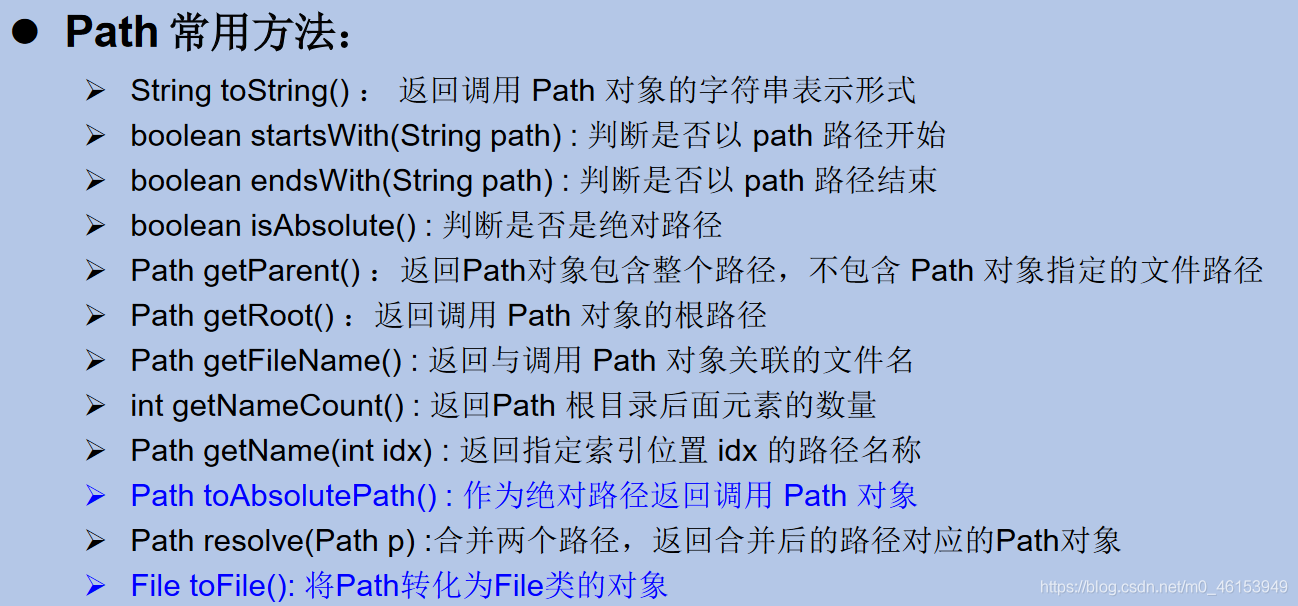
2、Files 类
